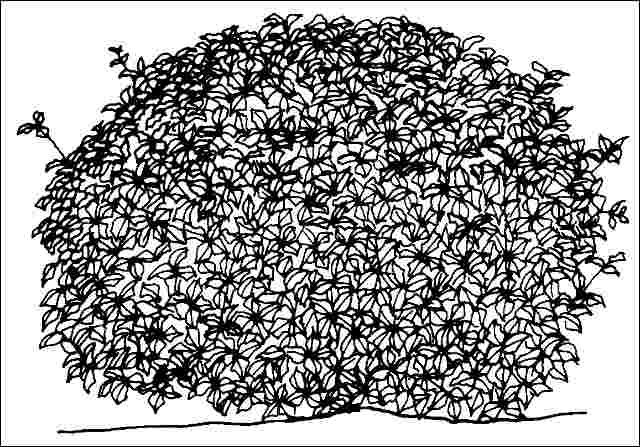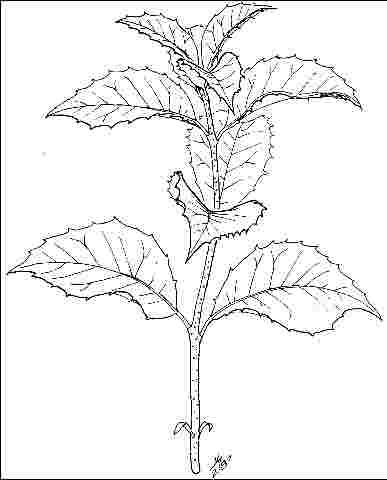Introduction
This large, vigorous, evergreen shrub or small tree grows 15 to 20 feet tall and forms a dense, round or oval silhouette. Very old specimens form a spreading vase. A hybrid of Holly Osmanthus ( Osmanthus heterophyllus ) and Fragrant Tea Olive ( Osmanthus fragrans ), Fortune's Osmanthus has the spiny, holly-like, dark green, white margined, leathery foliage of one parent plant and the extremely fragrant white flowers of the other. Frequently trimmed into a hedge or screen, Fortune's Osmanthus could be used more as a specimen or container planting, and the barbed leaves also make it suitable as a barrier planting. `Variegatus' has a nice appearance for a variegated plant.

General Information
Scientific name: Osmanthus x fortunei
Pronunciation: oz-MANTH-us x for-TOO-nee-eye
Common name(s): 'Variegatus' Fortunes Osmanthus
Family: Oleaceae
USDA hardiness zones: 7A through 9B (Figure 2)
Origin: not native to North America.
Invasive potential: has been evaluated using the IFAS Assessment of the Status of Non-Native Plants in Florida's Natural Areas (Fox et al. 2005). This species is not documented in any undisturbed natural areas in Florida. Thus, it is not considered a problem species and may be used in Florida.
Uses: hedge; screen; specimen; container or planter
Availability: not native to North America

Description
Height: 15 to 20 feet
Spread: 6 to 10 feet
Crown uniformity: symmetrical
Crown shape: oval
Crown density: dense
Growth rate: slow
Texture: medium
Foliage
Leaf arrangement: opposite/subopposite (Figure 3)
Leaf type: simple
Leaf margin: spiny, serrate, pectinate
Leaf shape: ovate, elliptic (oval)
Leaf venation: pinnate
Leaf type and persistence: evergreen
Leaf blade length: 2 to 4 inches
Leaf color: variegated
Fall color: no color change
Fall characteristic: not showy

Flower
Flower color: white/cream/gray
Flower characteristics: not showy
Fruit
Fruit shape: round
Fruit length: less than .5 inch
Fruit covering: fleshy
Fruit color: black
Fruit characteristics: does not attract wildlife; not showy; fruit/leaves not a litter problem
Trunk and Branches
Trunk/bark/branches: branches don't droop; not showy; typically multi-trunked; thorns
Pruning requirement: little required
Breakage: resistant
Current year twig color: gray
Current year twig thickness: thin, medium
Wood specific gravity: unknown
Culture
Light requirement: full sun, partial sun or partial shade
Soil tolerances: sand; loam; clay; acidic; well-drained
Drought tolerance: high
Aerosol salt tolerance: unknown
Other
Roots: not a problem
Winter interest: no
Outstanding tree: no
Ozone sensitivity: unknown
Verticillium wilt susceptibility: unknown
Pest resistance: resistant to pests/diseases
Use and Management
Fortune's Osmanthus should be grown in full sun or partial shade on any well-drained soil, including clay. Drought tolerance is good with established specimens apparently doing fine without irrigation.
The cultivar `San Jose' has cream to orange flowers.
Propagation is by cuttings.
Pests
Scales are one of the few problems. They can cause some defoliation if infestation is serious.
Diseases
Mushroom root rot when grown on wet soils is a disease that may infect this tree.
Literature Cited
Fox, A.M., D.R. Gordon, J.A. Dusky, L. Tyson, and R.K. Stocker (2005) UF/IFAS Assessment of the Status of Non-Native Plants in Florida's Natural Areas. Cited from the Internet (November 3, 2006), https://assessment.ifas.ufl.edu/